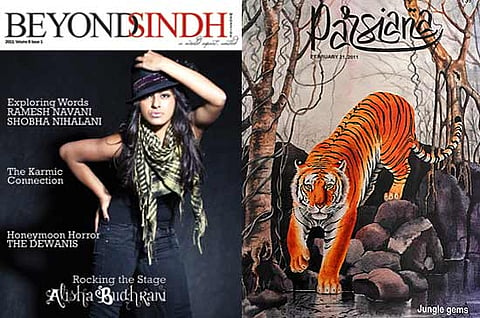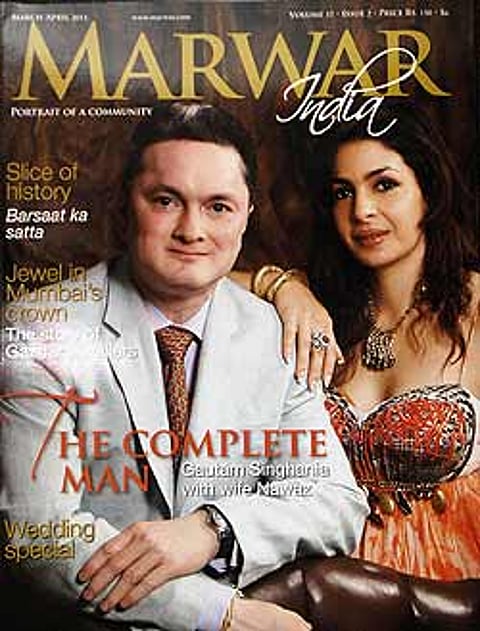Art Paper Boats
Glossy magazines help fill the void for desis looking to belong
Of-the-community, for-the-community and, sometimes, by-the-community glossies such as Marwar, The Sindhian, G2 The Global Gujarati, Beyond Sindh Magazine, Sada Punjab and Parsiana (the grand-daddy of community magazines that started in 1964) are thriving with an expanding readership base that stretches from the US, UK, Europe and Australia to South Africa, South America, China, Hong Kong, the Caribbean and yes, even your neighbourhood news stand, bookstore and mailbox.
But why, when the unanimous global buzzword is cosmopolitanism, would a Sindhi in Moscow or a Gujarati in Cape Town pick up such a specialised magazine? Jehangir Patel, editor of the fortnightly Parsiana, headquartered in Mumbai, explains: “Living in a cosmopolitan age makes it all the more important to fill the sphere of community news.” Rachana Mirpuri, publishing editor of the Hong Kong-based quarterly, Beyond Sindh Magazine, has felt that vacuum herself. “The lines between cultures and communities are getting blurred, and languages and customs are not as strong today as they used to be,” says Rachana, revealing how her faltering spoken Sindhi and niggling disconnect with the beliefs and rituals she’d grown up with became a cultural wake-up call.
So, in the summer of 2004, she started Beyond Sindh Magazine (with an all-Sindhi team to ensure that readers could connect with references to cultural idiosyncrasies without explanations) to better understand her own culture and share it with others like herself, and fete Sindhis who have scripted success stories in their chosen fields.

Community icons and achievers are, in fact, the stuff most cover stories are made of. Pritti Kumar, editor of G2 The Global Gujarati—Lokmat Media’s bi-monthly with a circulation of 40,000—recalls how the issues that had featured Tina Ambani, Kiran Majumdar-Shaw and Zia Mody brought in a host of reader emails.
Another cover that garnered reader reactions by the bucketloads was that of the last issue of The Sindhian—it featured Band Baaja Baaraat find Ranveer Singh Bhavnani and the actor’s legions of fans promptly lined up for copies.

Other well-thumbed pages in these glossies cover lifestyle, fashion, food, health, spirituality, heritage and entertainment. Weddings, as to be expected from such community-driven magazines, are popular too, making matrimonial alliances a big draw. G2’s wedding-special issue, predictably, is a sellout.
The concerns of the community also find voice—Jehangir counts the disposal of corpses, inter-faith marriages, conversions and elections to the Bombay Parsi Panchayat as among the most eagerly debated subjects in Parsiana.
Though the very nature of the journals puts them at risk of becoming glorified community newsletters, these plush publications are anything but. An impressive list of advertisers—Goliaths of the luxury market such as Porsche, Chopard, Audemars Piguet and Mont Blanc, besides hospitality and real estate majors among others—has ensured as much.
Pritti recalls how the initial brainstorming for G2 had hinged on fulfilling one crucial criterion—editorial quality had to be combined with advertising potential to match the profile of her target audience. “Gujaratis and Parsis are visible communities with an entrepreneurial bent and significant purchasing power. When luxury brands that started coming to India wanted to speak to me about their products, I realised it was because I am in touch with their potential client base,” Pritti says.
For Mumbai-based The Sindhian’s owner-publisher and editor Raaj Lalchandani too, the need to “put forth a contemporary and classy perspective on this community of achievers” remains paramount, even in his journal’s eighth year.
That need is shared by his peers. Like Maneck Davar, editor-owner of Spenta Multimedia’s Marwar (in its 17th year with 65,000 copies an issue), who aims to portray the aspirations of the Marwari community, “which is reputed to be mercantile, but has a heritage of its own culture, art, philanthropy and family values”.
How effectively one can play up that sense of belonging depends, of course, on how well one knows the audience. Of a typical patron, online magazine Sindhitattler.com writes: “The one who drinks JWB [that’s Blue], who attends more overseas and resort weddings than his board meetings, the one who is controlling the trading businesses worldwide, the one who has a cousin, friend, associate or relative in at least 50 countries.” In your face? Sure. Over the top? Maybe not. Jehangir argues why: “Since advertising is critical for the success of the publication, the community should be well placed financially and highly literate.”
Priced between Rs 125 and Rs 150—except the subscription-only Parsiana and Beyond Sindh Magazine, which costs Rs 600 for annual inland delivery (Rs 3,250 for airmail) and Rs 360 ($8) respectively—readers clearly don’t seem to mind. The magazines are, after all, an attractive package of a bit of their community’s past, a lot of its present and a glimpse of its future.
Tags